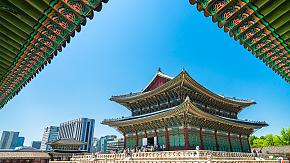Food in Korea: 10 Must-Try Dishes for Every Traveler
Tasting food in Korea is a vital part of traveling. Spicy kimchi can lift your spirits and cleanse your palate, the sizzling delight of BBQ chicken invites communal joy, and the light sweetness of tteokbokki (sweet & spicy rice cakes) can add a playful twist to your meal. Below are the top 10 foods you must try during your Korea tour.
- Kimchi - Salted and Fermented Vegetables
- Kimbap - Seaweed Rice Rolls
- Tteokbokki - Sweet & Spicy Rice Cakes
- Korean BBQ Chicken
- Bibimbap - Mixed Rice With Vegetables
- Bulgogi - Korean BBQ Beef
- Japchae - Stir-Fried Glass Noodles
- Jajangmyeon - Noodles in Blackbean Sauce
- Sundae - Korea Sausage
- Naengmyeon - Cold Noodles
Kimchi - Salted and Fermented Vegetables
Kimchi is the most iconic traditional Korean food made from fermented vegetables, most commonly cabbage and radishes, with various seasonings, including chili powder, garlic, and ginger.
Like the soul of Korean cuisine, kimchi is enjoyed almost every meal in a Korean family. It often served as a side dish in Korean cuisine, but it can also be used in soups, stews, and fried rice. Kimchi soup, made with kimchi, tofu, pork, or seafood, and kimchi pancakes, made with kimchi and a batter of flour and water, can be found in most Korean restaurants. It's worth trying for its unique tangy, spicy flavor, crunchy texture, and gut-friendly health.
Kimbap - Seaweed Rice Rolls
If you're not a fan of spicy food, kimbap (seaweed rice rolls) is a great choice - it's mild, nutritious, and perfect for sharing with friends. It is a staple food in Korea usually served with soup, and people of all ages enjoy it.
Kimbap is made by rolling cooked rice and other ingredients in gim (seaweed), and then slicing them into small pieces. Typical fillings include a variety of vegetables like carrots, spinach, and pickled radishes. Sometimes, kimchi, tuna, or cheese are also used.
This traditional Korean food can be customized to suit personal tastes or dietary preferences. Add protein like cooked beef, egg, fish cake, and crab meat if you're a seafood lover.
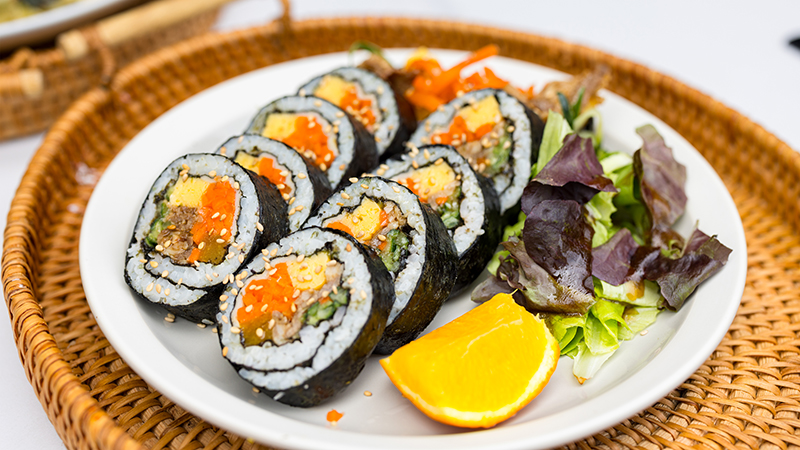 Kimbap
Kimbap
Tteokbokki - Sweet & Spicy Rice Cakes
This iconic red-orange cylindrical Korean street food is called tteokbokki (sweet & spicy rice cakes), the stir-fried rice cakes typically cooked with fish cakes and scallions in a sweet chili paste. If you enjoy spicy food, you'll fall in love with it because the more peppers, the better it tastes.
It's usually enjoyed as street food or snacks and pairs well with kimbap and BBQ chicken. While tteokbokki can be served with almost any kind of ingredients, relatively common types include cheese tteokbokki (topped with melted cheese for a creamy contrast to the spicy sauce), seafood tteokbokki (includes seafood like squid or mussels), and usually sprinkled with sesame seeds and chopped green onions as garnish.
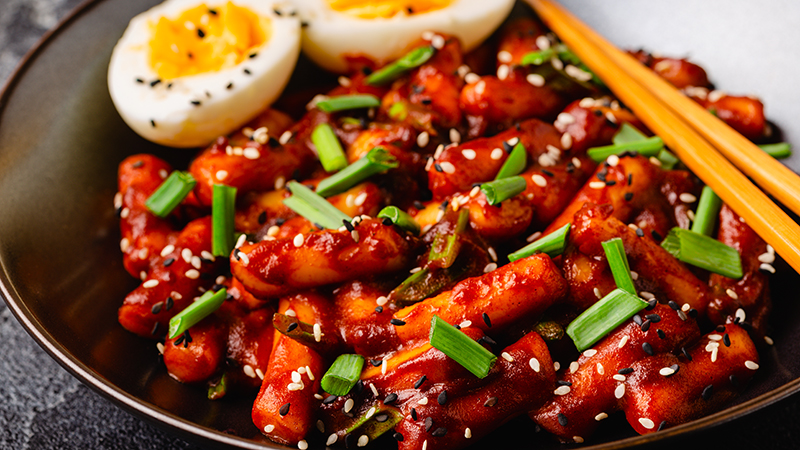 Tteokbokki
Tteokbokki
Korean BBQ Chicken
This BBQ chicken is a common dish for social gatherings. It's well-loved for being marinated, grilled, or fried chicken and has a savory and slightly sweet flavor. Unlike Western fried chicken, which tends to focus on the seasoning in the batter and breading, Korean BBQ chicken prefers a sweet and spicy sauce made from gochujang, garlic, and sugar. The taste is more intense and heavy.
BBQ chicken is often served with side dishes such as kimchi, pickled vegetables, and rice. It can also be accompanied by fresh lettuce or perilla leaves for wrapping the chicken, garlic, and green peppers. Beer with BBQ chicken is a great way to enjoy it, and millions of Koreans do the same way.
Bibimbap - Mixed Rice With Vegetables
Bibimbap (mixed rice with vegetables) is one of the most popular Korean foods among tourists, and it can be found widely in restaurants, food courts, and street markets. It's a flavorful and nutritious meal consisting of a bowl of warm rice topped with various vegetables, meat (including seafood like shrimp or squid), and a spicy sauce, all mixed just before eating.
Bibimbap in different regions has unique characteristics using a variety of ingredients, and a particular way to eat it is a hot stone pot dish that creates a crispy layer of rice at the bottom.
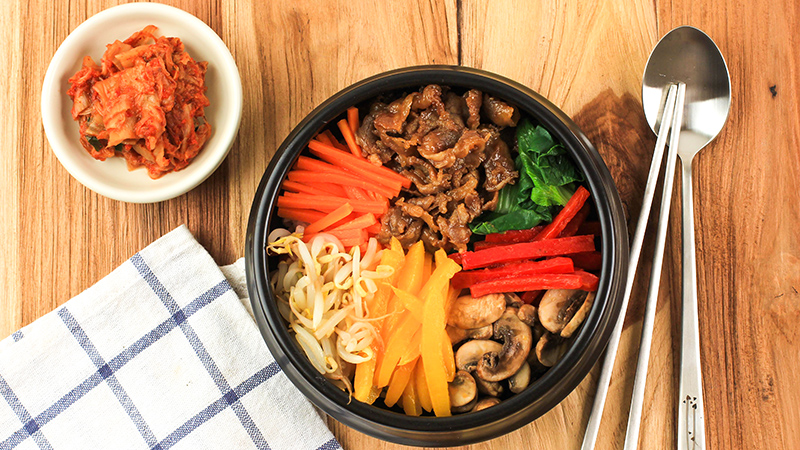 Bibimbap
Bibimbap
Bulgogi - Korean BBQ Beef
Korea bulgogi is thinly sliced beef (usually rib-eye or sirloin) marinated in sugar and soy sauce to your taste preference, rather than using various cuts and types of meat like regular barbecue. Once marinated, the beef is grilled or stir-fried to perfection, resulting in a succulent and juicy dish that embodies the balance of sweet and savory flavors.
For a traditional experience, you can place a piece of bulgogi in the center of lettuce or perilla leaves to make a wrap and savor the combination of flavors and textures. A more common way to enjoy it is to eat the grilled meat with rice and side dishes, savoring the complementary flavors with each bite.
Japchae - Stir-Fried Glass Noodles
Japchae (stir-fried glass noodles) is a popular Korean dish celebrated for its delightful combination of flavors and textures, which contain noodles and various vegetables, and sometimes meat or other proteins. The remarkable thing is that japchae is made from sweet potato noodles seasoned with soy sauce and sesame oil. The taste is slightly sweet or salty and chewy, and the color is bright.
You can enjoy japchae with other Korean dishes, such as kimchi and various banchan (side dishes). The tangy and spicy flavors of kimchi pair well with the slightly sweet and savory taste of japchae, creating a well-rounded flavor profile.
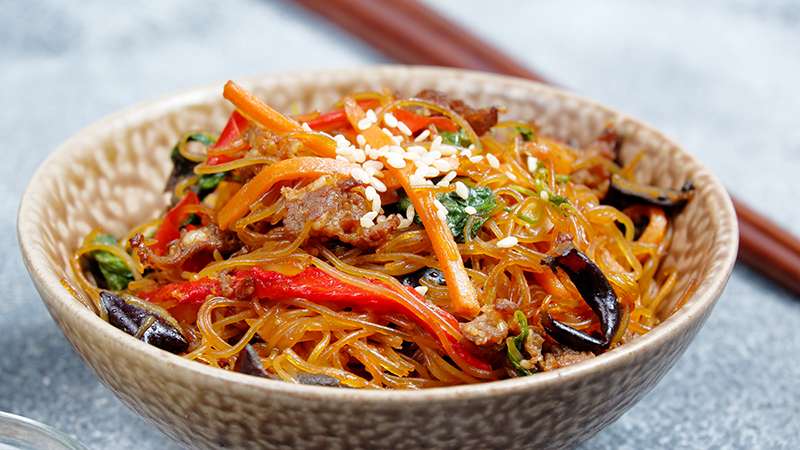 Japchae
Japchae
Jajangmyeon - Noodles in Blackbean Sauce
Jajangmyeon (noodles in blackbean sauce) is a popular food in Korea that appears in local dramas. Its cooking method involves preparing black bean paste with garlic and combining it with diced meat and vegetables. The mixture is then cooked until it thickens into a rich, flavorful sauce drizzled over cooked noodles.
You can find jajangmyeon at Korean-Chinese restaurants and street food stalls across Korea. To balance the salty and sweet flavors, serve with sliced raw onions and pickled radishes. It's an excellent meal, and paired with tangsuyuk (sweet and sour beef or pork) or dumplings, it creates a delightful dining experience.
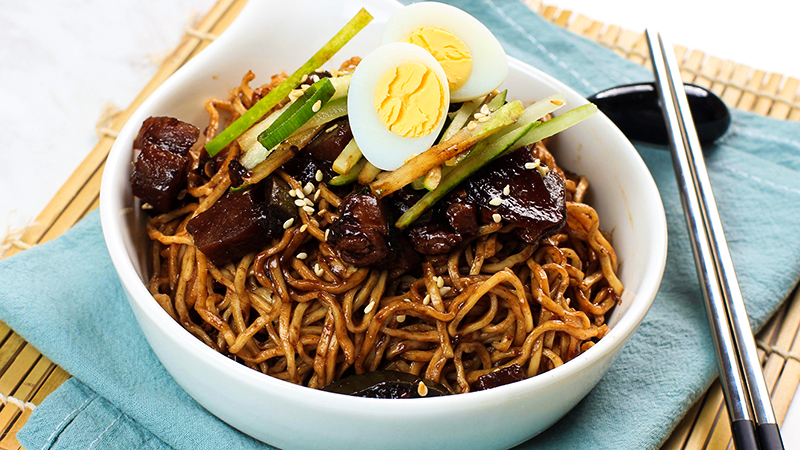 Jajangmyeon
Jajangmyeon
Sundae - Korean Sausage
Sundae (Korean sausage) is a unique and flavorful Korean dish that might surprise first-time travelers. However, it is also a must-try for adventurous food lovers. It is made by mixing pig's blood, glutinous rice, and vegetables into natural or synthetic casings and then steamed or boiled. Sundaes are usually seasoned with chili powder and salt, and have a strong flavor of pig blood. It's a popular lunch snack or late-night food because of its unique chewy texture and savory flavor.
Different regions in Korea have their own versions of sundaes, ingredients and consumption methods vary. For instance, the Seoul sundae is usually filled with chewy glass noodles, barley, and pig's blood.
The best pairing for sundae is with spicy sauce or a bowl of hot soup. If you prefer a stronger flavor, you can pair it with tteokbokki or sundae soup.
Naengmyeon - Cold Noodles
Naengmyeon (cold noodles), a traditional Korean dish, is especially popular in hot weather, offering a cooling way to beat the summer heat. Cold soba is an excellent choice for a light lunch or to refresh your taste buds after Korean BBQ. When serving, place the noodles in the icy broth, top with beef slices, cucumber, pear, and half a boiled egg, and add some kimchi on the side for a spicy kick.
Naengmyeon's unique charm lies in its refreshing and light taste, and the chewy noodles paired with the cold, tangy broth create a delightful feeling that keeps you returning for more.
Design Your Food Adventure With Odvnovo
Excited to explore Korea after reading our best Korean food guide? Reach out to us via [email protected] and we'll customize an itinerary that matches your interests, whether you're a food enthusiast or a casual traveler, Korea's diverse food scene promises an unforgettable culinary journey. Come to Korea with Odynovo and discover why its food is loved worldwide!
Quick Question
Related Posts You May Like
What Our Clients Say
Explore the latest verified reviews of Odynovo's travel services on Tripadvisor, Google, Trustpilot, Product Review and more trusted platforms.
SUBSCRIBE TO WIN A FREE TOUR
Subscribe to our newsletter for a chance to win a free 7-day tour to India! And more insider travel news, exclusive offers, and inspiration will be sent straight to your inbox. Check our previous newsletters and get some sparks.


